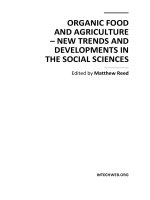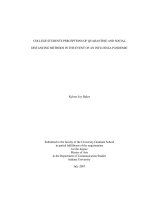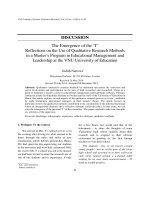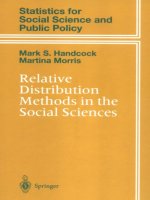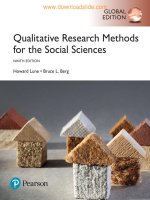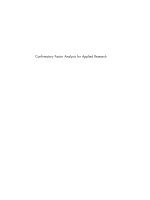Visual research methods in the social sciences stephen spencer, rputledge, 2011 scan
Bạn đang xem bản rút gọn của tài liệu. Xem và tải ngay bản đầy đủ của tài liệu tại đây (5.79 MB, 292 trang )
Visual Research Methods
in the Social Sciences
Visual Research Methods is a guide for students, researchers and teachers in the
social sciences who wish to explore and actively use a visual dimension in their
research. This book offers an integrated approach to doing visual research, showing the potential for building convincing case studies using a mix of visual forms
including: archive images, media, maps, objects, video and still images. The book
offers a critical review of some of the key theoretical ideas which underpin visual
research and in particular the critical analysis of urban landscapes and visual
identities.
Examples of the visual construction of ‘place’, social identity and trends of
analysis are given in the first section of the book, whilst the essays in the second
section highlight the astonishing creativity and innovation of four visual researchers.
Each detailed example serves as a touchstone of quality and analysis in research,
with themes ranging from the ethnography of a Venezuelan cult goddess to the
forensic photography of the skeleton of a fourteenth-century nobleman. They give
a keen sense of the motives, philosophies and benefits of using visual research
methods.
This volume will be of practical interest to those embarking on visual research
as well as more experienced researchers. Key concerns include the power of
images and their changing significance in a world of cross-mediation, techniques
of analysis and ethical issues, and how to unlock the potential of visual data for
research.
Stephen Spencer is a Senior Lecturer in Sociology at Sheffield Hallam University.
He has worked in both Further and Higher Education in Australia, with a background in anthropology and cultural and media studies. His previous works include
Social Identities: Multidisciplinary Approaches with Gary Taylor (Routledge,
2004); Race and Ethnicity: Culture, Identity and Representation (Routledge,
2006); and A Dream Deferred: Guyanese Identity Under the Colonial Shadow
(Hansib Press, 2006).
Visual Research Methods
in the Social Sciences
Awakening visions
Stephen Spencer
First published 2011
by Routledge
2 Park Square, Milton Park, Abingdon, Oxon, OX14 4RN
Simultaneously published in the USA and Canada
by Routledge
270 Madison Avenue, New York, NY 10016
Routledge is an imprint of the Taylor & Francis Group, an informa business
This edition published in the Taylor & Francis e-Library, 2011.
To purchase your own copy of this or any of Taylor & Francis or Routledge’s
collection of thousands of eBooks please go to www.eBookstore.tandf.co.uk.
© 2011 Stephen Spencer
The right of Stephen Spencer to be identified as author of this work has been
asserted by him in accordance with the Copyright, Designs and Patent Act
1988
All rights reserved. No part of this book may be reprinted or reproduced or
utilised in any form or by any electronic, mechanical, or other means, now
known or hereafter invented, including photocopying and recording, or in any
information storage or retrieval system, without permission in writing from
the publishers.
British Library Cataloguing in Publication Data
A catalogue record for this book is available from the British Library
Library of Congress Cataloging-in-Publication Data
Spencer, Stephen.
Visual research methods : in the social sciences / by Stephen Spencer. –1st ed.
p. cm.
Includes bibliographical references and index.
1. Visual sociology. 2. Social sciences–Research. I. Title.
HM500.S64 2010
2010018743
302.2′22–dc22
ISBN 0-203-88386-1 Master e-book ISBN
ISBN: 978–0–415–48382–7 (hbk)
ISBN: 978–0–415–48385–8 (pbk)
ISBN: 978–0–203–88386–0 (ebk)
Contents
List of figures
About the author
The practitioner essays
Acknowledgements
Introduction
viii
xiii
xiv
xvi
1
SECTION I
Visual research and social realities
9
1
Visualising social life
An evolving visual culture 11
Is seeing believing? 12
Aesthetics of the visual 16
Culture, image and meaning 17
Intertextuality 19
Surveillance, spectacles and simulations 23
The comfort of things: images and objects 29
Benefits of visual approaches 32
Summary 34
11
2
The research process and visual methods
The visual researcher 36
Getting started 41
Phenomenology 43
Ethnography 47
Case studies 50
Narrative research 52
Video production issues 58
36
vi Contents
Representation/reading strategies 60
Awakening vision: developing visual research in sociology 61
Ethics and visual research 65
Summary 67
3
Mapping society: a ‘sense of place’
Sense of place 69
Maps in visual research 71
Locating the site 79
Exploring the city 80
Drifting visions and dialectical images: everyday paradoxes
in a northern city 81
‘Foot-led’ ethnography 82
Born in fire and water 82
Persistence of memory – holes in the urban imagination 84
Industrial ruins 87
Signs of diversity – spectres of multiculturalism 93
Hardship and melancholia in the marketplace 95
Video ethnography: walking with a camera 100
69
4
Visualising identity
Visions of identity 111
Collective identities 119
El Charro – Mexican Iconography 120
Accessories in the environment 123
Body projects 123
Visual identity and product attributes 129
5
Visual analysis
132
Building relationships between images 133
Using stills to capture an ‘instance in action’ 136
Combined methods: ‘thick description’ in a case approach 137
Modes of analysis – semiotics 144
Paradigms and syntagms 146
Rhetorical images 147
Critical semiotic approaches 148
‘Punctum’ – the subversive focal point 156
Forms of discourse analysis 158
Using new technologies 164
110
Contents vii
SECTION II
Research practices in focus
167
Panizza Allmark – Towards a photographie féminine:
photography of the city
171
Sarah Atkinson – Multiple cameras, multiple screens,
multiple possibilities: an insight into the interactive film
production process
184
Roger Brown – Photography as process, documentary
photographing as discourse
199
Roger Canals – Studying images through images: a visual
ethnography of the cult of María Lionza in Venezuela
225
Conclusions
Glossary
Notes
Bibliography
Index
239
242
252
256
271
List of figures
All photographs, and models, by Stephen Spencer unless otherwise attributed.
Cover image: Public art – back wall of Rare and Racy, Sheffield, by Phlegm
(Spencer, 2010).
SECTION I
1 Visualising social life
1 Picture based on the cards used in the Asch conformity experiments.
2 Visions of ‘race’: (a) Hammerton, J. (c1932) People of the World,
Odhams; (b) Cuvier’s Natural History, illustration by Edward
Landseer (c. 1890).
3 Commission for Racial Equality poster, Scared? 1999, Sheffield.
The copyright and all other intellectual property rights in the material
to be reproduced are owned by, or licensed to the Commission for
Equality and Human Rights, known as the Equaity and Human Rights
Commission (the EHRC).
Model 1 Understanding the Image
4 Cabinet display Historico-Naturalis et Archaeologica, Dale Street.
Photograph by Karen Slinger, copyright © Robert Williams and Jack
Aylward-Williams 2009. Robert Williams. Principal Lecturer:
Fine Art, Programme Leader: Fine Art. School of Art and Design.
Faculty of Arts, University of Cumbria.
13
15
17
21
31
2 The research process and visual methods
5 Defaced statue of Queen Victoria in Georgetown, Guyana.
6 ‘After the Incidents, No. 1.’ Panizza Allmark (2006).
7 Video narratives. Top: Kumbutjil sign, Pariah website; middle:
still from Windrush Square (public domain image); bottom:
Lloyd Samuels (2006).
8 Wall mural, Broomhall, Sheffield.
46
54
56
63
List of figures ix
3 Mapping society: a ‘sense of place’
9 ‘Why?’ Indigenous artwork. With kind permission of artist
Daniel King (2004).
10 Carlisle ‘Renaissance’ map project created by Paul Taylor and Sue
Stockwell, 2009.
11 Hand-drawn maps: (a) Map of the Thicket (Spencer, 2009);
(b) Hartington Map (Surridge, 2009).
12 Frieze, Sheffield Town Hall.
13a The ‘hole in the road’ in the 1970s. Peter Jones.
13b The ‘hole’ being filled in. Sheffield Forum
(www.sheffieldforum.co.uk/showthread.php?=4550571).
14 Industrial ruins along the Sheffield and Tinsley Canal:
(a) Spencer (2009); (b) Surridge (2009).
15 (a) Heron on Brightside Weir; (b) information board telling the story
of the fig trees.
16 Warning signs, Sheffield.
17 ‘Sheffy Stan’ – botanic steelworker.
18 ‘Teeming’ by Robin Bell (1989–90) – Meadowhall Shopping Centre
(bronze).
19 Relief panels on a statue of Edward VII, Fitzalan Square: (a) Unity;
(b) ‘Philanthropy’.
20 Signs of multiculturalism, Sheffield, 2009.
21 (a, b) Traders near Castle Markets, Sheffield: (a) Surridge; (b) Spencer.
22 Signs of recession: Surridge (2009).
23 Bric-a-brac in a charity shop.
24 Venue for a car boot sale.
25 Africville. Image by Bob Brooks, 1960s. With permission of Public
Archives of Nova Scotia.
26 Stills from a short video walk in Africville in 2007.
27 Halfeti: ‘Only the Fish Shall Visit.’ Brogan Bunt, 2001.
73
74
76
85
86
86
89
91
92
92
93
94
96
97
98
98
99
102
104
107
4 Visualising identity
28 Matrix of cultural identity.
29 Ray Egan – a John Bull-style protest.
30 (a) Construction of the teenager; (b) The Gap: A Book to Bridge
the Dangerous Years. Ernest Wordsley (Editor). Artwork by: Art
Direction Ainslie Roberts. Artists: Barry Lines, Fred Stoward,
Ronald Bleaney, Winsome Patterson, and Don Allnut, of Adelaide
Art Engravers.
31 Scenes from The Gap – a ‘moral panic’.
32 El Charro: Zapata figures as a collective symbol.
33 The body as a project: (a) tattoos as personal expression (b) ‘the
world’s most pierced woman.’ With permission of Elaine Davidson.
112
113
115
116
121
124
x List of figures
34 Visual markers of class and taste. Richard McCarter (1999).
35 The TAC advertising campaign of 1989. With permission of
James Branagan (actor) and Grey Advertising, Australia.
126
128
5 Visual analysis
Model 2 Micro and macro relationships
135
36 Eight images from a case study:
1 Front page Northern Territory News, 2003. With permission of
Newspix.
139
2 ‘Nature/ Civilization’, Queensland Figaro, 6 August 1887. With
permission of Ross Woodrow, University of Newcastle, NSW.
3 ‘Postcard – Australian Aborigines’. With kind permission of Visit
Merchandise Pty Ltd.
4–7 Stills from a video, Framing the Fringe Dwellers.
8 Sign outside One Mile Dam, retrieved from Pariah.com.
Model 3 Levels of visual ethnogaphic research
141
37
38
39
40
143
144
145
41
42
43
44
45
Sequence of a moral panic.
Genealogy of a moral panic.
Paradigms and syntagms.
Italianicity revisited, 2009 (hotel theme cabinets, Carlisle) – Ibis
Publicity
‘Nature/Civilization’, Queensland Figaro, 6 August 1887. Permission
of Ross Woodrow, University of Newcastle, NSW.
‘In some countries…’: advert from The Australian newspaper c. 1983.
Australian Advertising Standards.
‘Negro women tending young sugar canes’ (Hammerton 1933).
Available discourses – postcard, ‘Australian Aborigines’. Darwin,
2005. With kind permission of Visit Merchandise Pty Ltd.
Digital Replay System, reproduced with permission of Nottingham
University.
149
151
154
157
160
165
SECTION II – PRACTITIONER ESSAYS
Panizza Allmark
1
2
3
4
5
6
Las Vegas, 1999.
New York (No. 1), 1999.
New York (No. 2), 1999.
London, 1999.
Buenos Aires (No. 1), 2008.
Buenos Aires (No. 2), 2008.
175
177
177
179
180
181
List of figures xi
Sarah Atkinson
1 The Crossed Lines screen presentation: all nine screens are visible
throughout the film.
2 The Crossed Lines telephone interface: the telephone keys numbered
1–9 simply map on to the nine screens.
3 Crossed Lines in production: the construction of the set for the
character in screen 7.
4 Crossed Lines in production: the director, Sarah Atkinson, on set
with actor Alan Carr who plays the character in screen 2.
5 Crossed Lines in production: the director, Sarah Atkinson, on set
with actor Lloyd Peters who plays the character in screen 5.
6 The Crossed Lines cinematic installation: a viewer interacts with
the large-scale version of the film.
7 The Crossed Lines installation on the road: at the International
Conference in Interactive Digital Storytelling (ICIDS), Guimarães,
Portugal, December 2009.
185
188
192
193
193
195
196
Roger Brown
1 Igniting the flare stack, Piper Alpha, North Sea (Occidental
Petroleum).
2 Fish filleting and processing shed, Aberdeen.
3 Royal Doulton Plc: Anne, aerobrush figurine decorator.
4 Hugh le Despenser the Younger, 1326, executed for High Treason.
Cervical vertebra C3 showing the inter-vertebral surface of the living
bone where it has been sliced through by beheading.
5 Froissart: The execution of Hugh le Despenser, Hereford, 1326.
6 HA16 (the surviving skeleton remains).
7 Cervical vertebra C3. This shows the moment of beheading. The
spongy appearance of the inter-vertebral surface shows the living
bone where the axe sliced through the flesh and fractured the neck
vertebra.
8 Cervical vertebra C3. Another view of the same site of beheading.
9 Lumbar vertebrae showing living bone surfaces. The body was
quartered and cut vertically down the lower spine from below the rib
cage to the pelvis.
10 The right clavicle where the right arm was cut away at the shoulder.
The bone shows as many as 12 cut lines, evidence of repeated slashing
and the difficulty of cutting through the flesh and sinews.
11 The thoracic section of the spine was also cut through vertically as
the body was butchered.
12 New housing along the Caldon canal where potbanks previously
stood.
13 Mrs Lottie Hughes, fourth-generation resident.
211
211
212
213
214
215
216
216
217
217
218
219
219
xii List of figures
14 Residents’ Association meeting with the Regeneration Agency.
15 Former paper mill and Victorian housing and new build housing,
Cresswell Street.
16 Mr and Mrs Jeffries.
17 The Christmas children’s lantern parade through the district.
18 The Hole in the Wall oatcake shop.
19 Glenn Fowler and the Oatcake Girls.
20 Exhibition at the Community Centre.
220
220
220
221
221
222
222
Roger Canals
1
2
3
4
5
María Lionza as La Reina (The Queen).
María Lionza as an indigenous woman riding naked on a tapir.
María Lionza as a highly sensual white woman.
The Blood and the Hen.
Visual schemes to demonstrate the relational character of the image
of María Lionza.
227
227
229
234
235
Glossary
46 Different spheres of cultural meaning
47 The structure of myth
246
248
About the author
Stephen Spencer has a background in Communications and Cultural Studies and
is a Senior Lecturer in Sociology at Sheffield Hallam University, having worked
as a lecturer in both Higher and Further Education in Australia and the UK. His
research into ethnic conflict in the Caribbean led to the publication of A Dream
Deferred: Guyanese Identity Under the Colonial Shadow (Hansib, 2006). In the
same year Race and Ethnicity: Culture, Identity and Representation (Routledge,
2006) was especially concerned with the way in which people are classified, and
in particular the role of images in popular culture as a means of circulating
mythical concepts of ‘race’ and multicultural identity. As well as these sole
authored texts, a co-edited monograph for CSAP, Reflecting on Practice: Teaching
‘Race’ & Ethnicity in Further and Higher Education (2006) sought to capture the
experiences of teaching issues of race and ethnicity in diverse settings. More recent
research has focused on visual methodologies for research and teaching and the
production of videos on consumerism, media representation of the Iraq conflict,
homeless Aborigines in Darwin and the complex meanings of multiculturalism.
Research in Nova Scotia in 2007 led to the publication of Identities in Transition:
Five African Canadian Women Discuss Identity, a video published in EliSS
Journal, CSAP, Online Publication, Vol. 1, Issue 2, Autumn 2008.
The practitioner essays
Dr Panizza Allmark
Dr Panizza Allmark is a senior lecturer and course coordinator for Mass
Communications and Media and Cultural Studies at Edith Cowan University,
Western Australia. Panizza is a documentary photographer and has exhibited
widely and published in the field of cultural studies. She is also the co-editor of
Continuum: Journal of Media & Cultural Studies. Her output has included articles
on gender and sexuality, art and photographic discourse, and her work has been
exhibited in New York, Urbino in Italy, Buenos Aires and in several galleries in
Australia. Panizza’s current work includes a photographic study of border towns
on the Thai–Burma border and interviewing and photographing Burmese Buddhist
peace freedom activist Ashin Sapaka.
Dr Sarah Atkinson
Dr Sarah Atkinson is Principal Lecturer in Broadcast Media at the University of
Brighton. Sarah is also a new media practitioner working within the field of
interactive visual and sonic arts. She has a PhD from Brunel University. ‘Telling
Interactive Stories’ is a practice-based thesis, which theoretically and practically
investigates the field of digital fictional interactive storytelling. Sarah has also
published articles around the area of interactive film, video and cinema. Dr
Atkinson’s Crossed Lines is an original fictional interactive film amalgamating
multi-linear plots, a multi-screen viewing environment, an interactive interface
and an interactive story navigation form. It has been exhibited at the Electronic
Literature Organisation conference at the Washington State University, US; the
Digital Interactive Media in Arts and Entertainment conference arts show
in Athens; The Interrupt arts show in Providence, US; the Euro ITV arts show in
Belgium and the International Digital Interactive Storytelling conference in
Portugal.
Roger Brown
Roger Brown is a Senior Lecturer in Photography at Staffordshire University,
Faculty of Arts. He is a practising and exhibiting documentary and studio still life
The practitioner essays xv
photographer and research-active in the fields of visual anthropology, visual
sociology, visual archaeology and hermeneutic philosophy. Roger Brown is also
a PhD doctoral research candidate in the practice, aesthetics and theorising
philosophical hermeneutics of documentary photography, visual ethnography and
visualising archaeology. His doctoral thesis is entitled ‘Documentary Photography
and the Hermeneutic Philosophy of Paul Ricoeur, 1913– 2005’. He has a growing
number of publications including Cassella, Brown, Lewis and Lucking (2008)
‘HASDiP: The Hulton Abbey Skeleton Digitisation Project, A Teaching &
Learning Resource’; DVD, JISC/HEA E-Learning research programme; ‘Digitally
visualising archaeological remains from the Hulton Abbey Archaeological
Excavations’ (Boothroyd and Klemperer, 2004). Roger’s recent exhibitions
include, in 2008 at Waterside South: Identity & Regeneration and an Arts Council
& RENEW North Staffordshire regeneration partnership Place, Space & Identity
1 Community Arts project, Wellington Community Centre and St Marks Church,
Wellington, Hanley, Stoke-on-Trent, Staffordshire.
Dr Roger Canals
Roger Canals is a Postdoctoral Professor and researcher at the University of
Barcelona where he currently teaches the Anthroplogy of Art (and specialises in
Visual Anthroplogy).
Dr Canals’s varied research interests include: visual anthropology, anthropology
of religion (studies in African-American cults in South America and abroad),
ethnographic cinema, and anthropology of art. His published work includes:
‘Double debt. Prints in the Cult of María Lionza (Venezuela)’ in Performance and
Representation in South American Shamanic Societies in C. Alès & M. Harris
(eds), (Oxford, Berhghan Books), in press, ‘Les avatars du regard dans le culte à
María Lionza (Venezuela)’ in L’Homme. Revue française d’anthropologie,
Éditions de l’École des Hautes Etudes en Sciences Sociales (Paris, in press). In
addition, he has produced, directed and filmed two ethnographic videos, The Blood
and the Hen and María Lionza: The Many Faces of a Venezuelan Goddess. Roger
Canals’s current projects include further research on the diaspora of María
Lionza’s cult in other Caribbean countries and in Barcelona. This research will
lead to a new ethnographic film and a number of articles on the place of AfricanAmerican religions in a globalised world. He is also preparing the publication of
his first book on the representations of María Lionza in Venezuela.
Acknowledgements
This book is the result of several projects; the main ones are listed at the end of the
introduction. It also draws on an unpublished PhD report for some of its critical
themes about research. The biggest debt is clearly to the four authors for providing
their practitioner essays which make up Section II of the text. These are essays
that demonstrate the diversity and innovation to be found in visual research today
and the wealth of critical insights which underpin such work. In addition to these
four contributors I would like to thank several other collaborators, notably Keith
Radley, Lloyd Samuels, Dave Surridge and Richard McCarter, for their video, still
images and drawings which are featured in this book.
Every effort has been made to contact the copyright holders for their permission
to reprint material in this book. The publisher would be grateful to hear from any
copyright holder who is not acknowledged and will undertake to rectify any errors
or omissions in future editions of the book.
Introduction
This book is intended primarily for students, particularly those in the later years
of social science degrees or those pursuing postgraduate research. Increasingly,
forms of visual research are being examined and the potential benefits are
attractive. Of course, I also hope it will be of interest to lecturers and researchers
like myself, who teach in the social sciences; in anthropology, sociology, cultural
and media studies or in qualitative research methods where these disciplinary
areas often collide.
Why should researchers in the social sciences focus their attentions on visual
methods? There are two compelling reasons for becoming a ‘visualista’.1 Firstly,
that the visual is recognised as central to the human condition and to expressions of humanity which pre-date language, affecting our emotions, identities,
memories and aspirations in a most profound way. We are visual beings in a
world which is a visual array of meaning. Secondly, despite this, social sciences
have undervalued the visual, or relegated its use to mere subsidiary illustrations
to written text. However, in the last two decades, the interest in the visual
dimension of social life has rapidly increased; the potential of visual methods to
provide a deeper and more subtle exploration of social contexts and relationships
is recognised, allowing us to see the everyday with new eyes.
This book aims to provide a guide to the thinking and planning processes
involved for employing different forms of visual research in the project of
understanding and representing crucial issues in social life. Arguably we are not
only an ‘interview society’ (Atkinson and Silverman, 1997) but also an obsessively
visual one verging, at times, on the voyeuristic. Academic knowledge and scholarship, once so logocentric (emphasising the written and spoken word), is changing
and developing, driven by rapid innovations in media and educational technologies, marking a cultural shift towards a society which is concerned with the
visual recording of everyday social behaviours. The camera’s intrusion into every
aspects of life is witnessed in the ascendency of reality TV and trends in
surveillance. Most academics now rely on more immediately visual displays using
PowerPoint and bespoke websites, blogs and galleries on Flickr or video clips from
YouTube, where before they would have presented in a more formal verbal style.
While the earliest cave paintings demonstrate that visual representations are
as old as human culture itself, it is language which has developed as an
2 Stephen Spencer
‘essentially perfect’ (Sapir, 1966: 1) means of communication in every society.
We believe in language; it is a bond which unites cultures, delineates relations of
belonging, identity and difference. Language is one of the facets of culture we
are most motivated to learn, enabling relative precision in the description of
complex concepts, emotions and other internal states. Pictures, on the other hand,
are less reliable as vehicles for conveying simple messages; a painting can of
course incorporate conventional codes and symbols, but a clear ‘reading’ of the
combination of elements and how they are intended by the artist may be difficult
to assess and open to multiple interpretations. Similarly, while the photographic
image is ‘indexical’, that is, a sign which is directly connected to that which it
portrays rather than one where the interpretation is based on arbitrary convention
(like the ‘?’ question mark or the other linguistic signs which have no natural
relationship to the things they denote) the meaning we deduce from such an image
is equally open to speculation.
So perhaps it is not surprising that most social research has seen visual
attributes of social life as less reliable or harder to categorise or generalise, and if
used they have been an addendum to the verbal discussion and traditional
language-based methods of research. Marcus Banks suggests: ‘the study and use
of visual images is only of use within broader sociological research enterprises, rather than as ends in themselves’ (Banks, 2001: 178). Research is often
enhanced by the inclusion of visual material which gives a broader context,
allowing a more detailed understanding of everyday social life. Key issues and
questions in sociology and anthropology can be examined in a manner which adds
intimate, particular and substantial detail to the exploration of social actions
which may be habitual and commonplace, and hence easily overlooked. Indeed
the visual saturation of western culture makes the visual a valid object of research
in its own right. This focus on visual aspects is considered by some theorists
(Jenks, 1995; Mitchell, 1994) to be indicative of a markedly ‘visual turn’ which
has come to characterise the era.
This text has been developed for those who wish to engage with the visual
elements of social phenomena as a valuable resource for supplementing the
traditional tools of qualitative methods for understanding about society, culture
and the increasingly visual nature of our everyday lives.
Structure of the book
The aim of this text is not to give a definitive grasp of the whole field – there are
already several books which might serve as more comprehensive guides to the
terrain; among the best are works by Gillian Rose (2007), Marcus Banks (2007),
Jon Prosser (1998), Sarah Pink (2007) and Doug Harper (2005). While owing a
debt to these pioneers and making reference to their insights, by contrast, this
book focuses on selected examples which allow discussion of the processes and
problems inherent in using and developing visual research as a practice. The
chapters deal with reflections on the process of research and the nature of imagery
drawing from several pieces of action research (outlined below). There is an
Introduction 3
emphasis on tentative development based on exploratory samples from the
author’s recent fieldwork experiences and, in addition, visual case studies and
essays about practice from four innovative researchers.
Chapter 1 considers some different aspects of visual phenomena, airing some
preliminary theoretical concepts. Chapter 2 explores the potential uses of visual
methods within a qualitative methodological framework, as well as issues of
ethical and analytical validity. Chapters 3 and 4 highlight two crucial areas of
social life: respectively, constructions of ‘place’ and social identities. In each
case, facets of these areas of enquiry are illustrated through actual research
samples, in the hope of offering a suite of ideas and approaches which will inspire
researchers in the field. Chapter 5 discusses the analytical task and gives examples
of semiotic and discourse analyses in action with follow-ups from some of the
projects already outlined. Analysis does not realistically begin only after the data
has been collected, it is implicit in the rationale and aims of the research and often
already visible in the construction of researcher-produced images and video
pieces. Finally, in Section II of the book, four very different and original visual
researchers give a brief account of their own research journeys.
Section I
To illustrate my tentative steps in visual research I have used examples from
several pieces of visual-based case study research I have been involved with in
the last few years. These are cited not necessarily because they are exemplars (in
fact they have many weaknesses not least in some cases less than professional
audio-visual results) but because they might demonstrate the gradual development
of a more critical visual approach and developing a sociologically adapted eye
(although this might sound like disciplinary blinkers!). The initial reason for
turning to video was to be able to bring vivid case material into my teaching as
inspiration for both subject knowledge and research techniques and theoretical
understanding of complex issues.
1. Spencer, S., Sawyer, S. and Surridge, D. (2003) War and
Propaganda: Closing the Public Mind
A short unpublished video examining the management of media during the Iraq
war of 2003, protest, and public reactions to media coverage, theories of media
influence and the propaganda model. This is an unpublished resource used in
teaching which is based on a series of interviews with three professors of media:
Bob Franklin (Cardiff University), David Miller (Glasgow University Media
Group) and Richard Keeble (University of Lincoln). In addition, the video draws
on a number of street interviews with the public in Sheffield.
4 Stephen Spencer
2. (i) Framing the Fringe Dwellers (2004), Academic video. Available on
C-SAP Website ( />(ii) Framing the Fringe Dwellers: Visual Methods for Research & Teaching
Race & Ethnicity: A Sample Case Study (2006), in Max Farrar and
Malcolm Todd (2006) Teaching Race in Social Sciences – New Contexts,
New Approaches, C-SAP Monograph, Birmingham.
[Available Online] http:// www.c-sap.bham.ac.uk/resources/publications/
monographs/ teaching_race/
Australia has a complex indigenous heritage encompassing several hundred
‘Aboriginal’ groups with unique languages and traditions. However, the consequences of invasion rates of incarceration and the legacy of the ‘stolen generation’ (forcible removal of Aboriginal children), and continuous pressure from
developers on already small parcels of land, has had a catastrophic impact on
many communities, dislocating them from their traditional areas and leading to
many indigenous people being trapped in an impoverished and pressured state.
There is often a struggle to obtain even the most basic amenities in the midst of
mono-cultural Australian affluence. This film (also a journal article and chapter in
a book) focused on one specific site of this heritage, Darwin, in the Northern
Territory, an area with a larger proportion of diverse indigenous peoples than
other states of Australia. Yet these disparate groups enjoy an uneasy existence
on the edges of the city in a few poorly resourced and crowded housing estates or
in informal camps. It is an existence which at times brings them into conflict with
the local government, the white community and concerns for the image of the
city and the burgeoning tourist trade.
This video focused on the case of indigenous people in Darwin and was used
as a vehicle for theoretical and practical reflections on exploratory attempts to
use the medium (digital video and stills) both for research and to address issues
in the teaching of race and ethnicity. There are two key concerns which the use of
video is well suited to address. Firstly, the need to present voices of people who
are affected by regimes of racism, social exclusion and powerlessness; to hear
their story and to present their viewpoint while giving some cultural context to the
case. This study raises a number of important questions about visual ethnography
and the importance of developing an ethical and engaged practice which
embraces collaborative and intersubjective approaches to research.
3. Spencer, S. and Radley, K. (2006) Under the Skin of Multiculturalism,
Academic video. Available on C -SAP website: chingrace.
bham.ac.uk/video_resources/
The intention behind this project was to create a video resource for learning and
teaching which addressed some of the issues arising from the often bewildering
and contradictory interpretations of ‘multiculturalism’; exposing doubts, fears
and the lived realities of an increasingly diverse society. The team set out to
Introduction 5
develop a visual approach charting the twists and turns in cultural and political
discourses of diversity; from a sense of celebration and enjoyment of difference
and the often palliative perceptions of multiculturalism through to current
concerns about segregation, militancy and terrorism. Drawing on archive films,
stills, live interviews and original music, the video provides a visually interesting
and provocative account. Street interviews, voices from individuals in different
communities (South Asian, African and African-Caribbean) as well as academics
from the UK, US and Europe have been sampled to present a range of definitions
and interpretations of multiculturalism. Especially of interest are the debates
about the perceived tension between equality and difference, core and peripheral
views of identity and citizenship, and anxieties over secularism and religion. This
project was designed as a flexible series of materials for students and lecturers to
open up debate into serious issues of race and ethnicity; the video exposes
assumptions and embedded values, asking about the social and political realities
which drive the changes.
4. Drifting Visions & Dialectical Images: Everyday Paradoxes in a Northern
City (2009) (Illumina Issue 3, Dec 2009 e-journal, Edith Cowan
University)
This project is a visual study of Sheffield exploring the contradictions and
visual paradoxes of a city which is deeply scarred by transitions, the chaos of
deindustrialisation and the constant attempts at re-invention. This article is largely
reproduced in a section of Chapter 3. This is also an ongoing project which
includes video, and a website which was constructed by colleague Dave Surridge
–
5. Spencer, S. and Samuels, L. (2010) Looking for Africville
An academic video and article examining the story of Africville; an early,
autonomous community of largely African-Canadian settlers in Nova Scotia. The
experiences of Africville residents survive through their powerful accounts of
an area which was stigmatised and neglected by mainstream white society
and eventually destroyed. At the centre of this case study is a piece of visual
ethnography, employing video, stills archive materials and interviews. The
specific focus of the paper is an examination of particular facets of qualitative
visual research; the uses of walking and movement in ethnographic records, and
the focus on oral narratives and how these may contrast with the ‘official’
histories.
Section II
Having experienced the range of new visual research which is happening at
several conferences since 2006, I wanted to include space in this book to give a
sense of the dynamism and creativity of visual research. Therefore, I approached
6 Stephen Spencer
four innovative researchers from across the social science disciplines to give a
short account of the philosophies and purposes behind their practices with
reflections on specific projects they have undertaken. The work ranges through
sociological and cultural studies to anthropology, as well as specific discussion of
hermeneutics of the visual, film genres, narrative structures and of course
photographic aesthetics and practice.
Panizza Allmark – Edith Cowan University, Western Australia:
Towards a photographie féminine: photography of the city
Allmark explores the city photographically, developing an embodied approach
which breaks from the rational and comfortable masculine tradition of the
landscape as beautiful, picturesque or transcendent. She challenges this with a
feminist counter-aesthetic of the uncanny which portrays the city as an indeterminate and potentially ominous space. A wide-ranging discussion of the city
includes examples from London, Las Vegas and Buenos Aires, while examining
the relationship of photography to identity, through a subtle use of the stylistic
documentary tradition developed by Atget, a seminal photographer of the early
twentieth century, and innovative political practice.
Sarah Atkinson – University of Brighton: Multiple cameras, multiple
screens, multiple possibilities: an insight into the interactive film
production process
Crossed Lines (Dir: Sarah Atkinson) is an original fictional interactive film
amalgamating multi-linear plots, a multi-screen viewing environment, an interactive interface and an interactive story navigation form. It has been exhibited
at the Electronic Literature Organisation conference at the Washington State
University, US; the Digital Interactive Media in Arts and Entertainment conference arts show in Athens; The Interrupt arts show in Providence, US; the Euro
ITV arts show in Belgium and the International Digital Interactive Storytelling
conference in Portugal. This essay reflects upon the creative processes of
devising, scripting, directing and authoring the interactive film installation in
which the viewer is given control over the flow, pace and ordering of the videobased narratives. The entire production process from script-writing to the final
installation took place over a four-year period and involved nine principal cast
members, numerous crew personnel, technicians, programmers, various cameras,
audio-recording equipment, cutting-edge computer processors, reams of cable
and a precariously soldered telephone. The complexities of undertaking and
delivering such a project are reflected upon and discussed within this essay from
the first-person perspective of the artist herself.
Introduction 7
Roger Brown: Photography as process, documentary photographing as
discourse
Recent discussions about photography concentrate on two perspectives: as a
method in a complex of sociological methodology, and as a text to be variously
evaluated, analysed and de-coded (Banks, 2007; Rose, 2007). Both views rest on
the assumption that photographs offer a representation of knowledge and a
correspondence to an empirical truth. Rarely is the making of photography
discussed, yet there is much to be learnt from doing so (Becker, 1994; Banks,
ibid.). This article focuses on the process of making documentary photographs
of sociological value. On what Maynard refers to as the process of photographing
and thinking through photography and Rorty as edification (Maynard, 2000;
Rorty, 2009). Referring back to Szarkowski and his five-fold aesthetic of
photography I shall argue that photographing is a process of thoughtful and
ethical social interaction and hermeneutic whose value combines observation and
aesthetics, or as Ruskin put it many years ago, ‘a mutual dependency on Form
and Mental Expression’ (Ricoeur, 1991; Ruskin, 1853).
Roger Canals, an anthropologist and film maker, University of
Barcelona: Studying images through images: a visual ethnography
of the cult of María Lionza in Venezuela
Visual anthropology has been defined as a discipline which integrates three
different fields: the study of images as an object, the use of images as an ethnographic method and the construction a visual discourse (through film or
photography) to present the conclusions of the research. The aim of this article is
to give an ethnographic example of how these three dimensions of visual
anthropology can be combined in an innovative and creative way. From 2005 to
2007, I was doing fieldwork in Venezuela on the representations of María Lionza,
one of the most important goddesses of the country. My objective was to study
both the iconography and the social role of this image, but rapidly I realised that
I could only achieve this goal critically using images during my fieldwork and
constructing an anthropological discourse in which images had an autonomous
position.
The ingredients are varied but collectively address some of the crucial issues
of visual research touching on methodology and ethics, and the boundary between
individual subjectivity and developing a visual practice which adds valid
expression and in-depth analysis to the social sciences.
